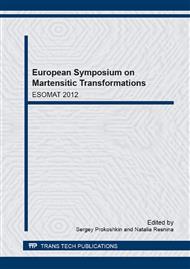[1]
V.F. Zackay, E.R. Parker, D. Fahr and R. Bush, Trans. Am. Soc. Met., 60 (1967) 252-259.
Google Scholar
[2]
W.W. Gerberich, P.L. Hemmings, M.D. Merz, V.F. Zackay, Trans. Techn. Notes, 61 (1968) 843-47.
Google Scholar
[3]
H.K.D.H. Bhadeshia, D.V. Edmonds, Metall. Trans., 10A (1979) 895-907.
Google Scholar
[4]
Y. Sakuma, O.Matsumura, H. Takechi, Metall. Trans. A, 22A (1991) 489-98.
Google Scholar
[5]
B.C. De Cooman, Curr. Opin. Solid State Mater. Sci., 8 (2004) 285-303.
Google Scholar
[6]
S.K. Liu and J. Zhang, Metall. Trans. A, 21A (1990) 1517-25.
Google Scholar
[7]
I.B. Timokhina, P.D. Hodgson, E.V. Pereloma, Metall. Mater. Trans. A, 35A (2004) 2331-2341.
Google Scholar
[8]
P.J. Jacques, J. Ladrière, F. Delanny, Metall. Mater. Trans. A, 32A (2001) 2759-2768.
Google Scholar
[9]
O. Matsumura, Y. Sakuma, Y. Ishii, J. Zhao, Iron Steel Inst. Jpn. Int., 32 (1992) 1110-16.
Google Scholar
[10]
E. Pereloma, H. Belladi, L. Zhang, I. Timokhina, Metall. Mater. Trans. A, 43A (2012) 3958-3971.
Google Scholar
[11]
G. Reisner, E. A. Werner, P. Kerschbaummaur, I. Papst, F.D. Fischer, I. Met., 49 (1997) 62-65.
Google Scholar
[12]
M. De Meyer, D. Vanderschueren, B.C. De Cooman, Iron Steel Inst. Jpn. Int., 39 (1999) 813-22.
Google Scholar
[13]
H.C. Chen, H. Era, and M. Shimizu, Metall. Trans. A, 20A (1989) 437-45.
Google Scholar
[14]
V.T.T. Miihkinen and D.V. Edmonds, Mater. Sci. Technol., 3 (1987)422-30.
Google Scholar
[15]
E.V. Pereloma, I.B. Timokhina, M.K. Miller, P.D. Hodgson, Acta Mater., 55 (2007) 2587-2598.
Google Scholar
[16]
B.V. Kovacs, On the terminology and structure of ADI, Trans. AFS, 102 (1994) 417- 420.
Google Scholar
[17]
B.D. Cullity, Elements of X-Ray Diffraction, Addison-Wesley Publishing Company Inc., 1978, p.555.
Google Scholar
[18]
M.K. Miller, Atom Probe Tomography, Kluwer, Academic/Plenum Press, New York, 2000.
Google Scholar
[19]
E. Pereloma, L. Zhang, K.-D. Liss, U. Garbe, J. Almer, T. Chambron, H. Beladi, and I. Timokhina, Solid State Phenomena, 172-174 (2011) 741-46.
DOI: 10.4028/www.scientific.net/ssp.172-174.741
Google Scholar
[20]
J. H. Chung, J.B. Jeon, Y. W. Chang, Met. Mater. Int., Vol. 16, No. 4 (2010), p.533~541
Google Scholar
[21]
I. Tsukatani, S. Hashimoto, T. Inoue, ISIJ International, 31 (1991) 992-1000.
Google Scholar
[22]
M. Takahashi and H.K.D.H. Bhadeshia, Materials Transactions, JIM, 32 (1991) 689-696.
Google Scholar


